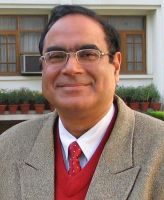Subscribe to Stay Informed
Student Enrichment through Global Collaboration project at WVNCC
Posted 04/26/12Faculty members at a college in India and at West Virginia Northern Community College during the current academic semester have been collaborating online, and students at both institutions are the beneficiaries.
 The “Student Enrichment through Global Collaboration” project has been spearheaded by Dr. Purnima V. “Pam” Sharma, professor of physics/mathematics at Northern. She explained the project is designed to engage students and faculty in the two countries to gain a firsthand perspective on current topics related to social, economic, judicial and cultural issues.
The “Student Enrichment through Global Collaboration” project has been spearheaded by Dr. Purnima V. “Pam” Sharma, professor of physics/mathematics at Northern. She explained the project is designed to engage students and faculty in the two countries to gain a firsthand perspective on current topics related to social, economic, judicial and cultural issues.
Sharma said, “We’re using technology to provide our students perspective on those issues, giving them an opportunity they normally would not have. This is an excellent way to assist in reaching the goals of a traditional liberal education.”
The professor began formulating ideas for the collaboration nearly a year ago. Then, last November, Sharma traveled to India. During her one-week stay, she met with faculty at DAV College in Chandigarh, India, and offered a demonstration of the proposed collaboration. “They liked it,” she said, and shortly after the start of the spring 2012 semester in January Sharma began pairing faculty from Northern with faculty in India and the group began sharing ideas for topics of discussion.
Faculty members at Northern involved in the collaboration also include Crystal Harbert, instructor of English; Delilah Ryan, associate professor of history; and Don Poffenberger, professor of criminal justice. “After we analyze the data gleaned from this collaboration, hopefully that will lead to further faculty participation” at both institutions, Sharma said.
After her demonstration to the DAV faculty in India, Sharma was told about 50 students there enrolled in the project. Participating faculty members in India include Dr. Virender Vats, Professor Anil Sarwal, Professor Avanindra Chopra, Dr. Kanwal Preet, Professor Sakoon N. Singh, Dr. Meenu Vats, Dr. Ravinder Dogra, Professor Manpreet Kaur, among others.
Sharma explained the student interactions are provided using two discussion forums: a “virtual online café” and an “intellectual discussion forum.” Topics of discussion for the online café were selected by students in the two countries based on student interests. Discussion topics in the intellectual discussion forums were agreed upon by the faculty members from the two institutions to provide a meaningful discourse.
She said selection of the topics were appropriate to the academic level, student interests and common educational goals. Faculty members mutually decided the time for which the topic remained active. Participation directions and guidelines were provided to ensure all discussions are appropriate and conducive to the educational and cultural values of the two countries.
 At the completion of the project, Sharma said, discussion messages from the two forums will be analyzed for the quantity and quality of interaction, quality of learning and added value of collaboration and critical thinking skills. A student survey will be conducted to evaluate student perspective on the global collaboration project. Findings of the project will be used to extend collaboration projects in the future.
At the completion of the project, Sharma said, discussion messages from the two forums will be analyzed for the quantity and quality of interaction, quality of learning and added value of collaboration and critical thinking skills. A student survey will be conducted to evaluate student perspective on the global collaboration project. Findings of the project will be used to extend collaboration projects in the future.
Sharma is pleased with the collaboration thus far, and cited comments from faculty members in Wheeling as well as those in Chandigarh.
Singh, a DAV faculty member, said, “I feel that this student enrichment project is a creative and fun way to share knowledge outside the traditional classroom. In fact, it allows us to widen and play around with the definition of the classroom itself. Students as well as faculty who are lucky to be a part of this program are set to learn how knowledge itself widens out when you put it out there to share.”
Sarwal, another professor at DAV, said he believes he is “greatly privileged to be associated with” the project “as in the emerging global village, teachers and students need to develop understanding of what is happening in the other parts of the world and learn from each other. This is a great opportunity for cultural exchange and crossing cultures that should be an important landmark of twenty-first century education, as one of the pillars of education for the present era is to ‘learn to live together.’
Concerning his expectations for the collaboration, Sarwal explained, “I look forward to gain insights on American literature from the American teachers and students, just as they would have an opportunity to learn about the Indian writing in English and our culture and ethos through our comments.”
Sharma said, “This is precisely what collaboration is all about, and the technology and skills available provide an educational bridge between our two countries.
